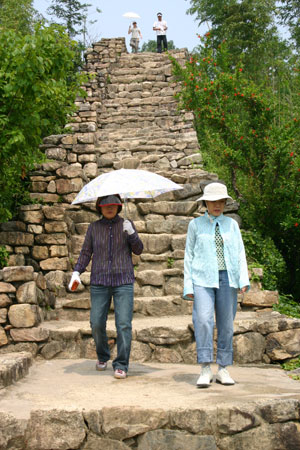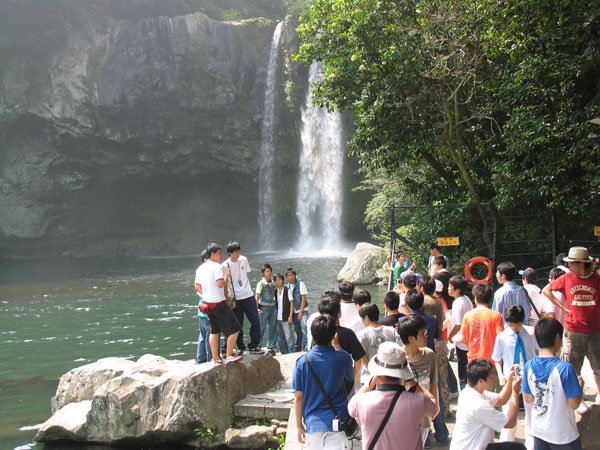JEJU ISLAND, SOUTH KOREA - Why were outcasts and criminals always exiled to the most beautiful places on Earth back in ancient times?
Remember when Australia was the dumping ground for Great Britain’s less desirables?
Well, this lovely volcanic island off the southern tip of Korea once served as an outpost for this country’s criminal element as well.
Jeju Island now captures the hearts and minds of 21st century visitors with its amazing natural beauty and collection of wonderful tourist attractions, first class hotels and championship golf courses.
Jeju City, the island’s capital, is where most tourists gather – along pristine beaches and in modern hotels – most of the five-star variety that are priced more like three-star properties. The island is a favorite with domestic travelers – a place where many weddings take place – so finding accommodation on Jeju isn’t always easy. After all, over four million Koreans visit Jeju Island annually.
Much of South Korea’s history and culture is connected with Jeju Island. In downtown Jeju City, for instance, is where you’ll find the Samseonghyeol, the sacred holes from which the three ancestors of the Jeju people are said to have come. The island, which sits 80 miles off the mainland, is known as the “island of the gods” and its typography and tropical environment mirrors that of Hawaii – right down to the heavy rain that comes on you unexpectedly.
This is the part of Korea where the famous pearl divers – all women – hunt for their precious harvest in the choppy surf that laps the rocky shores here. They wear only a mask, wet suit and fins and stay below the surface for long times – a feat that is amazing to watch from the rocky shoreline.
“I think I see one over there – and another there,” shouted Mr. Kim (everyone here seems to be named Mr. Kim) as we drove along the coast road that connects Jeju City and its busy airport and port with the rest of the island looking for pearl divers. The divers are literally a dying bread – cultured pearls are in far more in demand these days. The few divers that are left – “most young women have no ambition to become pearl divers,” Mr. Kim told us – still make a very good living at their craft but even that can’t lure younger divers.


Above: Jeju Island is full of lovely traditional temples and villages and some Garden of Eden settings.
It’s the natural wonders that draw most people to this treasured island. Natural beauties like the Cheonjaeyeon Waterfall, a 70 foot cascade that drops into a magical pool of water. The waterfall was named after seven nymphs who assisted the mythical “Heaven’s Emperor” who, legend has it, descended at night to bathe and play in the waterfall’s pool.
The colorful foot bridge that leads people to the steep staircase leading to the falls is one of the most colorful you’re ever likely to see. The arch-like bridge is painted red and white and is highlighted by a leafy green backdrop. The bridge, called Sonimkyo, has seven nymphs carved into it, and stretches across a dramatic valley. It has become one of the most photographed sites on Jeju.
The two favorite beaches on Jeju are Hyeopjae Beach and Hallim Park. Hyeopjae is famous for its glistening white sands while Hallim is more suited to families because of its gently sloping water depth.
Like the rest of Korea, Jeju has its fair share of temples, the largest of which is Yakcheon-sa, whose bookend towers are two of the most impressive in the temple world.
The island’s culture is preserved and celebrated at the Jeju Folk Village, a very impressive complex where a network of underground tunnels will impress and cool you from the heat and humidity. Here, you’ll learn how the early settlers overcame the monumental challenge of turning the volcanic landscape into lush farming land – an achievement that even today is hard to fully appreciate.
A drive along the Dumunpo Seashore reveals some of the strangest animal-like rock outcroppings in the world. The most impressive collection of nature’s sculpted rocks is at Yongdu-am, known locally as Dragon Head Rock.
Jeju is dotted with many lava caves with Gimnyeong-gul and Manjang-gul (gul means cave) being the most impressive. Both are the largest known lava tubes in the world and are now designated national monuments. The caves’ interiors, featuring lava pillars that stretch as much as 20 feet in height, are truly spectacular.
Jeju Island (known as Cheju to Koreans), is the fishing and agricultural capital of South Korea. Here, fresh fruits like pineapples and tangerines and a full range of vegetables grow in the fertile black soil and the island’s tea is one of its largest exports. The waters off Jeju are thick with fish – squid, octopus, sea cucumber and many other varieties are found here in great abundance – so freshness is never an issue.
Recreational sports top the list of activities on Jeju Island, with golf becoming the most popular in recent years, thanks mostly to the country’s incredible success on the Ladies Professional Golf Association (LPGA) circuit.
The courses here are mostly top quality and one, Nine Bridges, was ranked the 95th best in the world by U.S.-based Golf Magazine. The island, one of the most sought after golf destinations in Asia, offers four to seven-day golf tours.
Jeju is a captivating place – a place where a life sentence would be very welcomed.
About the Author
Marc Atchison is a veteran journalist and a seasoned traveller with more than 20 years of travel writing experience. As the former Travel Editor of the Toronto Star, Canada's largest newspaper, and now Editor-in-Chief and Senior Writer for TraveLife magazine (Canada) and travelife.ca, Marc has been to over 100 countries in the world. Japan is one of his favorite destinations and he's been there on numerous occasions.